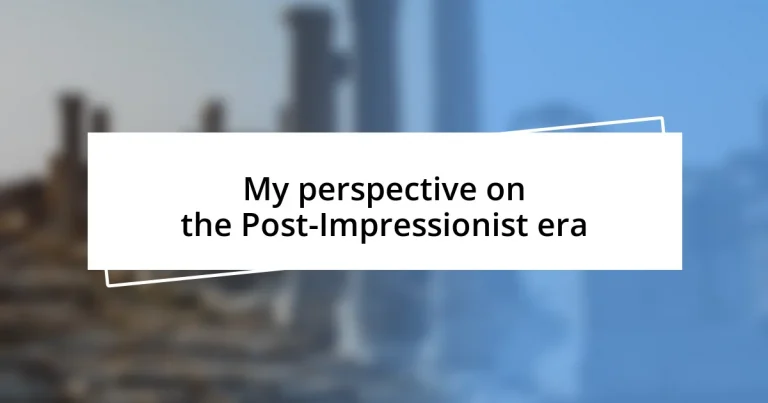Key takeaways:
- Post-Impressionism marks a shift from Impressionism, focusing on emotional expression, personal perspective, and abstraction in art.
- Key artists like Van Gogh, Cézanne, Seurat, and Gauguin contributed distinct techniques that emphasized bold colors, texture, and viewer perception.
- The cultural context of the late 19th century, including societal changes and psychological exploration, deeply influenced the artistic movements of the era.
- Post-Impressionism continues to inspire modern artists, fostering emotional authenticity and innovative expression in contemporary art forms.
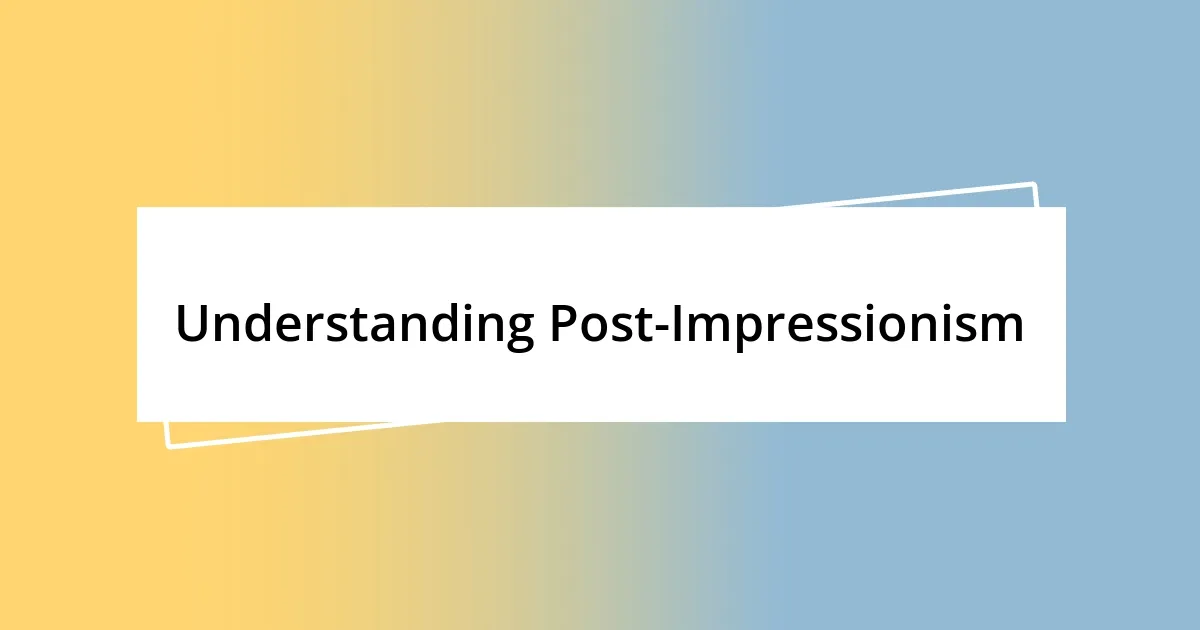
Understanding Post-Impressionism
Post-Impressionism, as I see it, emerges from a pivotal moment in art history. It’s fascinating how artists like Vincent van Gogh and Paul Cézanne sought to move beyond the fleeting effects of light that defined Impressionism. Instead, they embraced color, form, and emotional expression, creating works that resonate with deep, personal meaning.
When I first encountered works like Van Gogh’s “Starry Night,” I felt an overwhelming connection to the swirling patterns and vibrant colors. It struck me that these artists were not just depicting reality; they were conveying their internal experiences. Isn’t it incredible how art can evoke such powerful feelings? This emotional dimension is what truly sets Post-Impressionism apart, inviting viewers to explore their own interpretations.
Moreover, the shift toward abstraction in this era invites us to consider the role of personal perspective in art. I often wonder how my own experiences shape the way I perceive these artworks. For example, when I look at Cézanne’s still lifes, I can almost feel the weight and texture of the objects — it’s a testament to how Post-Impressionists challenged us to engage with art on a deeper, more subjective level.
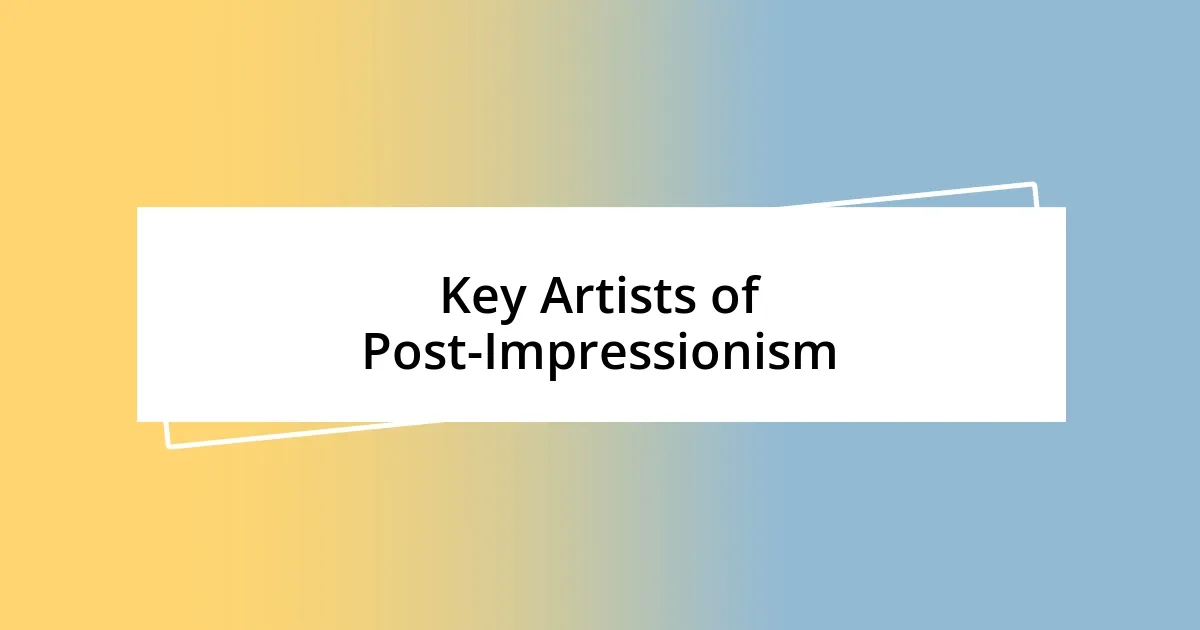
Key Artists of Post-Impressionism
When I think about the key artists of the Post-Impressionist era, a few names immediately come to mind. Each artist brought their unique flair, pushing boundaries that would influence many generations to come. Their works reflect not only their artistic styles but also their emotional journeys, which resonate with me deeply when I view them.
-
Vincent van Gogh: Known for his vibrant colors and dramatic brushwork, I still recall the first time I gazed at “The Irises.” The raw emotion in his colors made me feel as if I could almost hear the flowers whispering their stories.
-
Paul Cézanne: Often considered the father of modern art, his approach to form and structure has lingered in my mind. I remember examining his still lifes and feeling a sense of calm from the solid shapes, as if I were privy to a secret world within the canvas.
-
Georges Seurat: His technique of pointillism intrigued me when I first learned about it. I could spend hours gazing at “A Sunday Afternoon on the Island of La Grande Jatte,” losing myself in the meticulous dots that come together into a vibrant scene, reflecting the beauty in details.
-
Paul Gauguin: I was particularly moved by his quest to symbolize spirituality through color. The bold hues in “Where Do We Come From? What Are We? Where Are We Going?” invite introspection and lead to a personal dialogue that I find uniquely compelling.
Each of these artists challenges me to reflect on the visual language of emotions and experiences, reminding me of the importance of personal connection in art. Their innovations not only defined an era but also shaped my own understanding of artistic expression.
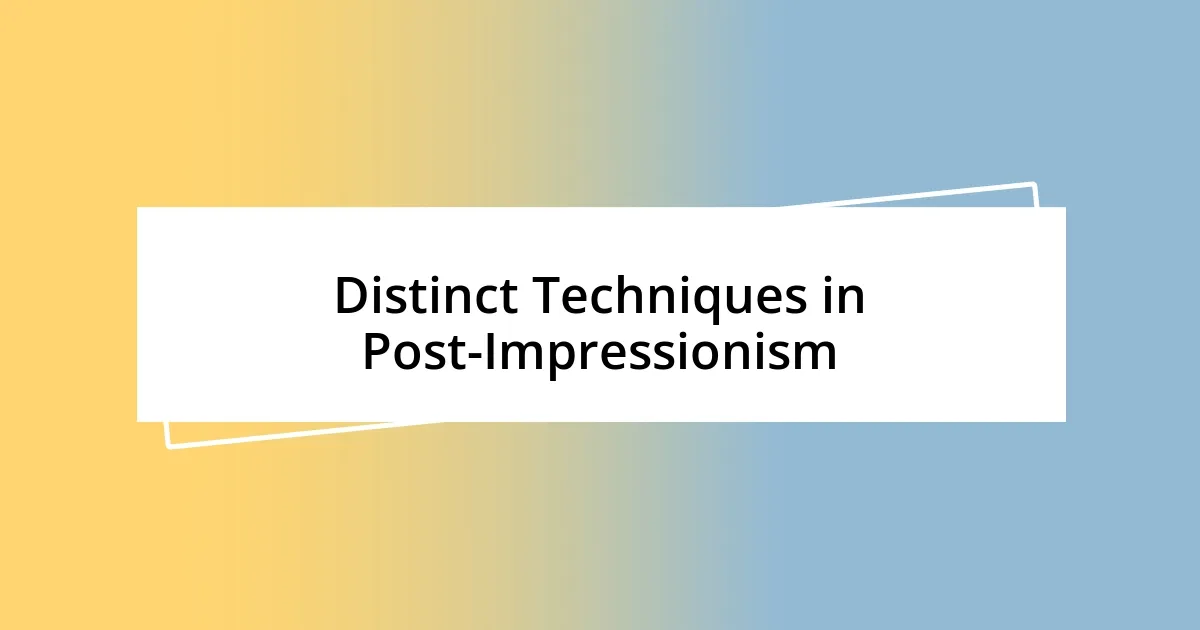
Distinct Techniques in Post-Impressionism
Distinct techniques in Post-Impressionism truly captivate me. One defining method is the use of bold, non-naturalistic color. Van Gogh’s strokes highlight this; his palette radiates emotion, as seen in “The Night Cafe.” The vivid reds and greens create an almost overwhelming sense of tension. I remember standing in front of that painting, feeling the room’s isolation wash over me — color, in this sense, becomes a language of its own.
Another technique that stands out is the focus on brushstroke and texture. Cézanne famously dissected objects into geometric shapes. When I reflect on his landscapes, particularly “Mont Sainte-Victoire,” I can almost touch the layers built up on the canvas. Every brushstroke communicates solidity, transforming the ordinary into something profound and engaging. It reminds me of the layers we all carry in life, hidden yet impactful.
Then there’s Seurat’s pointillism, which fascinates me for its meticulousness. His process of creating images from tiny dots compels me to marvel at the complexity of perception. I recall a visit to an art museum where I gazed at “A Sunday Afternoon on the Island of La Grande Jatte” and felt as if I were part of the scene. Each dot invites closer inspection, sparking thoughts on how perspectives shift with distance and detail.
| Technique | Description |
|---|---|
| Bold Color | Expressive colors used to convey emotion, as seen in Van Gogh’s works. |
| Brushstroke and Texture | Emphasis on textured strokes to create depth, evident in Cézanne’s landscapes. |
| Pointillism | Technique of using tiny dots to form an image, exemplified by Seurat’s paintings. |
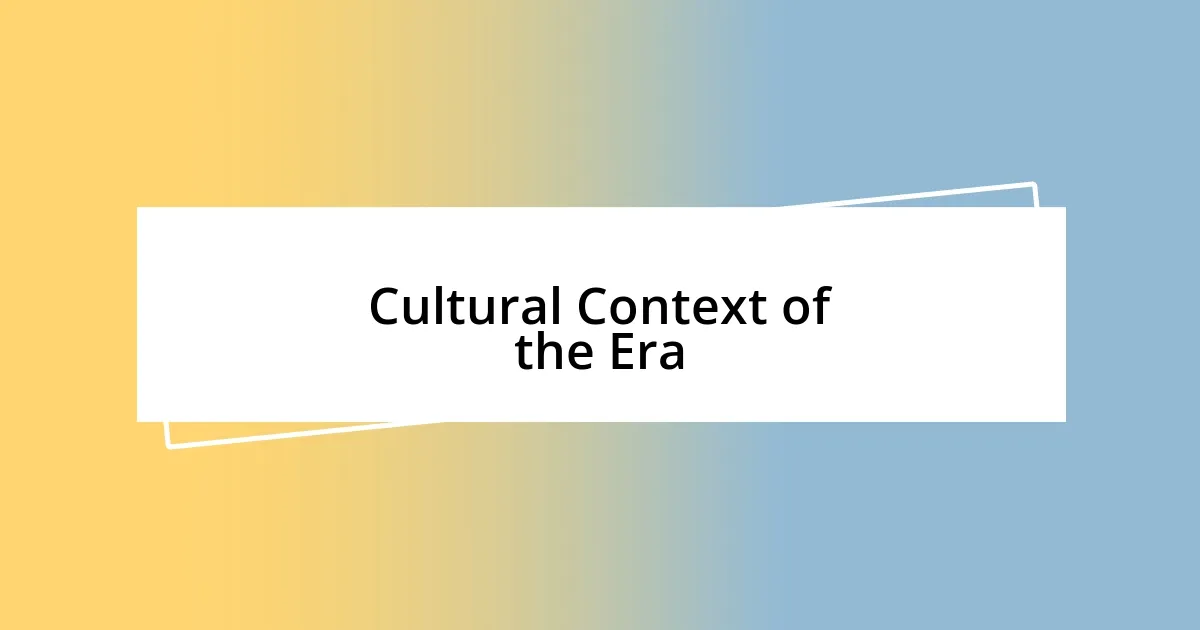
Cultural Context of the Era
The cultural context of the Post-Impressionist era is rich and multifaceted, filled with social changes and vibrant debates. When I think back to the late 19th century, it was a time of upheaval and transformation. The industrial revolution was changing the fabric of society. I remember reading about how more people were moving to cities, leading to a shift in perspectives as they grappled with modernity and the fast pace of life.
During this era, there was also a growing interest in psychology and individual perception, which deeply influenced the art itself. Artists like Vincent van Gogh seemed to embody this shift so much. I often find myself pondering how his mental struggles influenced his expressionistic style. It’s fascinating to think about how emotions and personal experiences became integral to artistic exploration, forcing art to break away from traditional subjects and techniques.
Moreover, the rise of avant-garde movements challenged the norms of the art establishment. I wonder how the boldness of the Post-Impressionists made it possible for future generations of artists to feel free in their own creative expressions. The dialogues around art were becoming more inclusive, paving the way for diverse voices to emerge. This breaking down of barriers resonates with me, as it speaks to the importance of freedom in creativity and self-expression. What a privilege it is to be part of a continuing art conversation!
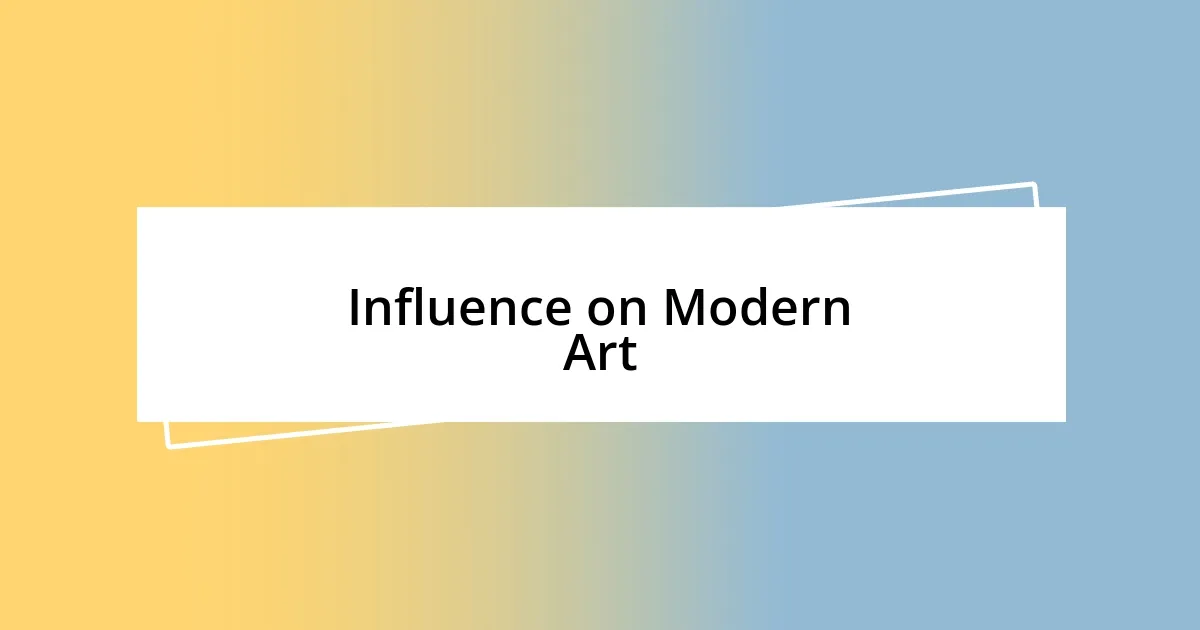
Influence on Modern Art
The influence of Post-Impressionism on modern art cannot be overstated. When I view contemporary works that embrace thick, expressive brushstrokes, I often think back to Van Gogh’s powerful approach. It’s as if those artists are carrying forward a tradition of emotional authenticity, translating feelings into visual language. I find myself wondering: how might Van Gogh have reacted to today’s digital art forms?
There’s also a tangible connection to abstraction in modern art rooted in Post-Impressionist techniques. Artists today often break away from realism much like Cézanne did in his depictions of nature. Watching a modern artist dissect their canvas with geometric shapes feels like a direct lineage from his work. I can’t help but smile when I think of how this conversation between past and present continues to evolve; each artist builds upon the achievements of their predecessors.
Moreover, the fascination with viewer perception, richly illustrated by Seurat’s pointillism, resonates deeply in our age of immersive and interactive art experiences. I recently wandered through an exhibit where visitors were encouraged to step into a digital environment reminiscent of Seurat’s scenes. It was intriguing to realize how participation transformed the experience. It led me to reflect on this question: how can modern art, like Post-Impressionism, continue to shape how we see and understand the world around us?
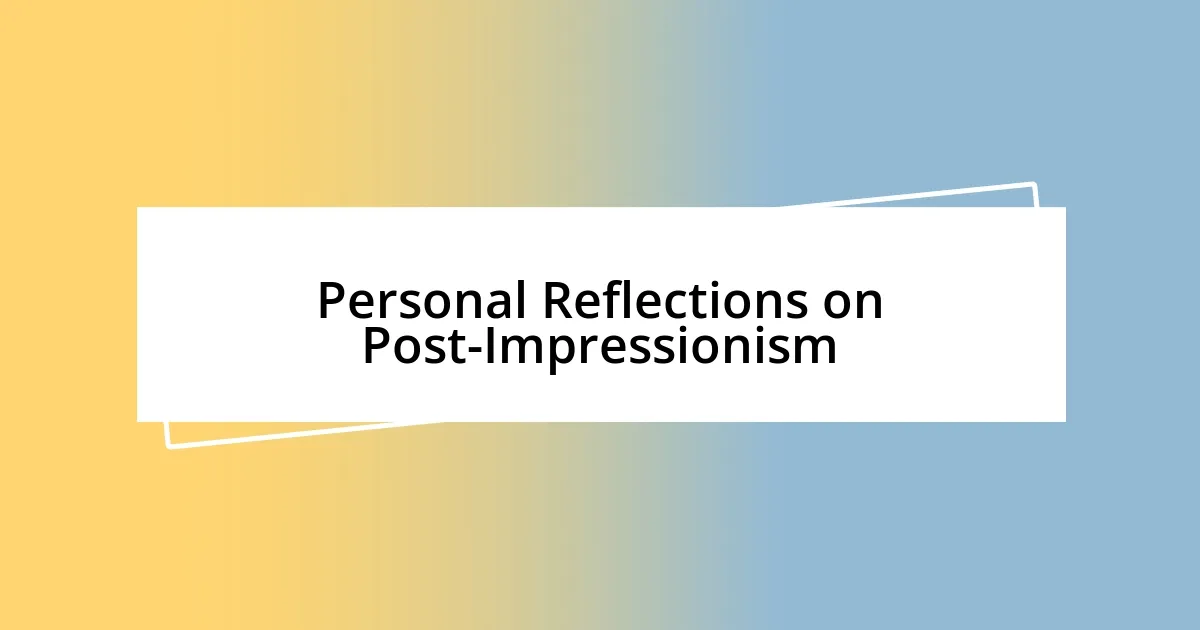
Personal Reflections on Post-Impressionism
When I reflect on Post-Impressionism, I can’t help but feel a deep connection to the emotional intensity these artists conveyed. I remember standing in front of a Van Gogh painting for the first time, engulfed by the swirls of color and raw energy. It struck me how he could capture such profound feeling, making me question my own emotions in that moment. How is it that colors and forms can provoke feelings so strong they almost pull you into the canvas?
What resonates with me the most is how Post-Impressionist artists challenged societal norms through their work, allowing their unique perspectives to shine. I think back to a workshop I attended where we explored unconventional art techniques influenced by Post-Impressionism. The joy and freedom I felt while experimenting with color and form reminded me that breaking away from tradition can be liberating. Isn’t it incredible how art can empower us to express our individuality?
In many ways, I view the Post-Impressionist era as a canvas where emotion dances with innovation. There’s something magic about how these artists embraced their inner worlds, forming a bridge to our modern expressions. I often wonder: how might we continue this legacy today, allowing each brushstroke, each digital pixel, to tell our own stories? Art truly becomes a living dialogue, evolving with every generation.
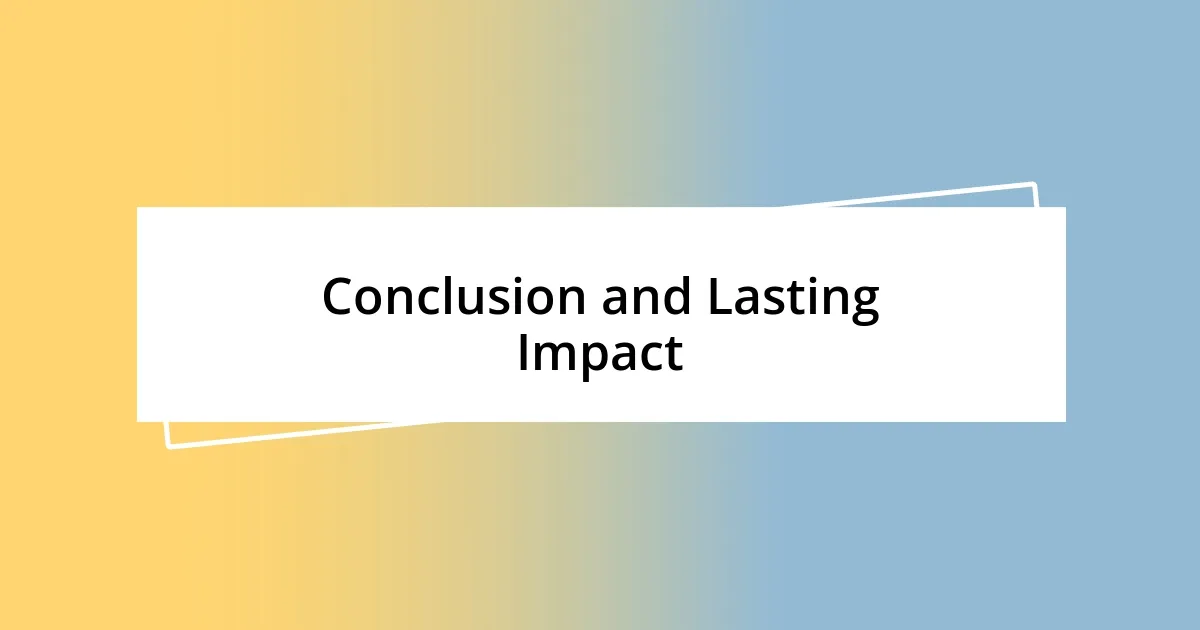
Conclusion and Lasting Impact
The Post-Impressionist era leaves a powerful legacy that continually inspires artists today. One evening, while sketching in a café, I felt this magical connection to their innovative spirit. I realized that every line I drew was a tribute to the bold choices made by the likes of Gauguin and Van Gogh. How thrilling it is to recognize that we are all part of this evolving story!
Additionally, the emotional depth infused into Post-Impressionist artworks invites us to think about our own experiences. I recall walking through an art fair that showcased contemporary pieces inspired by this movement. Each artwork spoke to me in different ways, reminiscent of the emotional echoes I felt immersed in a Van Gogh masterpiece. Isn’t it fascinating how the heart of Post-Impressionism continues to pulse through the art we create and consume today?
As we move forward, the questions that arise from Post-Impressionism challenge us to dig deeper. How can we harness that emotional authenticity in our own artistic pursuits? I find it exciting to think of the bridges we can build, linking our current artistic expressions back to those pioneers who dared to be different. It’s this interplay between the past and future that keeps the art world vibrant and full of possibility.












